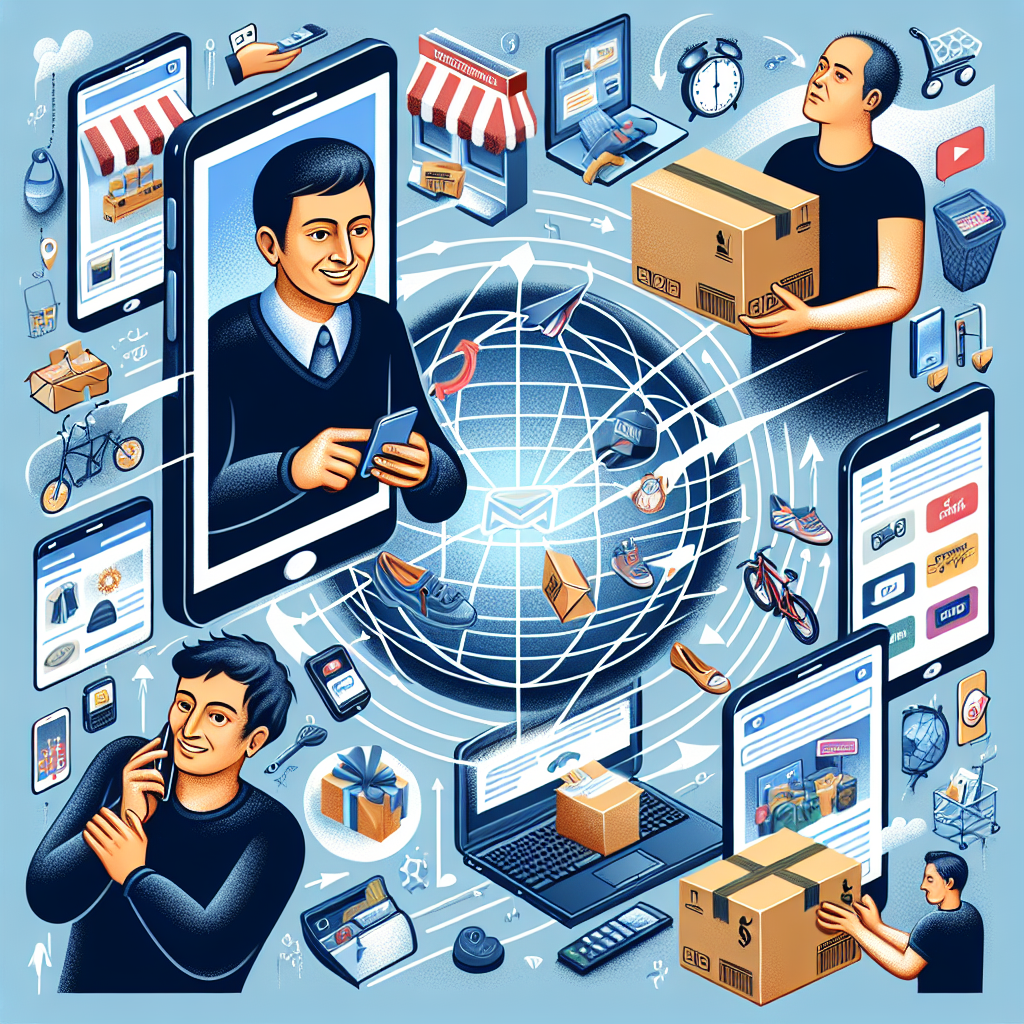In today’s digital age, the rise of mobile high speed internet has revolutionized the way we shop online. With the convenience of browsing and purchasing from the palm of our hands, online shopping has never been easier or more accessible. This comprehensive guide explores the impact of mobile internet on the world of online shopping, delving into the ways in which our smartphones and tablets have transformed the way we shop. From the convenience of browsing on-the-go to the seamless checkout process, mobile internet has empowered shoppers to make purchases with just a few taps. Join us on a journey through the world of mobile internet and discover how it has revolutionized the online shopping experience.
Understanding the Role of Mobile Internet in Shaping Online Shopping Behavior

In recent years, the proliferation of mobile internet usage has significantly impacted the way consumers engage in online shopping activities. This section delves into the key aspects of how mobile internet has shaped and transformed online shopping behavior.
- Exploring the growth of mobile internet usage for online shopping
The advent of smartphones and the widespread availability of mobile internet connectivity have revolutionized the online shopping landscape. Statistics indicate a substantial increase in the number of consumers using their mobile devices to browse, research, and make purchases online. This trend underscores the growing preference for the convenience and flexibility offered by mobile platforms in accessing e-commerce websites and applications.
Mobile internet usage for online shopping has witnessed a steady upward trajectory, with a notable shift towards mobile-centric shopping experiences. Consumers now rely on their smartphones and tablets to explore product options, compare prices, read reviews, and complete transactions seamlessly. The portability and instant accessibility of mobile devices have contributed to the surge in mobile shopping activities, transforming traditional retail practices and influencing purchasing decisions.
- Analyzing the convenience and accessibility factors driving mobile shopping
One of the primary drivers of mobile shopping behavior is the unparalleled convenience and accessibility that mobile internet offers to consumers. With just a few taps on their screens, shoppers can browse through a vast array of products, place orders, and track deliveries in real-time. The anytime, anywhere access to online stores empowers consumers to shop on the go, whether they are commuting, waiting in line, or relaxing at home.
Moreover, the seamless integration of mobile payment options and secure checkout processes has further streamlined the online shopping experience, eliminating barriers to purchase and enhancing transaction security. The convenience of storing payment information and shipping addresses on mobile devices simplifies the checkout process, reducing friction and encouraging impulse buys.
As a result, the convergence of mobile internet technology and e-commerce has reshaped consumer shopping habits, fostering a culture of instant gratification and personalized shopping experiences. The ability to receive tailored recommendations, exclusive deals, and instant notifications via mobile apps has heightened consumer engagement and loyalty, driving the growth of mobile commerce in the digital marketplace.

The Influence of Mobile-Friendly Websites and Apps on Online Shopping Experience
In the realm of online shopping, the advent of mobile internet has revolutionized the way consumers interact with e-commerce platforms. A pivotal component of this transformation lies in the development of mobile-friendly websites and applications that cater to the ever-evolving needs of the modern shopper. Let’s delve into the significance of these mobile-optimized interfaces and how they have shaped the online shopping experience.
- Importance of Responsive Design for Seamless Mobile Shopping
Mobile-friendly websites and apps are designed to adapt seamlessly to various screen sizes and resolutions, ensuring that users can navigate through the online shopping interface effortlessly, regardless of the device they are using. Responsive design plays a crucial role in this adaptation, as it allows the layout and content of the website to adjust dynamically based on the screen dimensions, providing a consistent and user-friendly experience across different devices.
By prioritizing responsive design, online retailers can eliminate the frustration of distorted layouts, unclickable buttons, or slow loading times that often plague non-optimized websites on mobile devices. This streamlined user experience not only enhances customer satisfaction but also contributes to higher conversion rates and increased sales for businesses.
- Enhancing User Experience through Mobile-Optimized Interfaces
In the competitive landscape of online shopping, user experience is paramount in determining the success of an e-commerce platform. Mobile-friendly websites and apps play a pivotal role in enhancing the overall shopping experience for consumers on the go. These interfaces are specifically tailored to meet the unique browsing behaviors and preferences of mobile users, offering a seamless and intuitive journey from product discovery to checkout.
Through mobile-optimized interfaces, online retailers can leverage features such as simplified navigation, quick loading times, secure payment gateways, and personalized recommendations to create a tailored shopping experience that resonates with mobile shoppers. By prioritizing user-centric design principles, businesses can foster customer loyalty, drive repeat purchases, and establish themselves as leaders in the mobile commerce space.
In conclusion, the influence of mobile-friendly websites and apps on the online shopping experience cannot be overstated. By embracing responsive design and prioritizing user experience, e-commerce platforms can harness the power of mobile internet to connect with consumers on a deeper level, driving growth and innovation in the ever-evolving landscape of online retail.
Benefits of Mobile Internet for Online Shopping
The mobile internet has revolutionized the online shopping experience, offering a plethora of benefits to consumers. These benefits include:
- Increased flexibility and convenience: Mobile internet enables shoppers to browse and make purchases at their convenience, eliminating the need to be tied to a desktop computer. Whether waiting in line, commuting, or relaxing at home, consumers can easily access online stores and complete transactions using their smartphones or tablets.
- Access to a wider range of products and services anytime, anywhere: With mobile internet, online shoppers have the world of e-commerce at their fingertips. They can explore a vast array of products and services from various retailers and vendors without being limited by physical store hours or locations. This accessibility allows consumers to compare prices, read reviews, and make informed purchasing decisions on the go.
Challenges and Limitations of Mobile Internet for Online Shopping
The Influence of Mobile-Friendly Websites and Apps on Online Shopping Experience
- Security concerns regarding mobile transactions
As online shopping via mobile devices becomes increasingly popular, security concerns related to mobile transactions have emerged as a significant challenge. Consumers are often wary of sharing their personal and financial information on smaller screens, fearing potential data breaches or unauthorized access. The limited screen space on mobile devices can also make it more difficult for users to verify the authenticity of websites, leading to a higher risk of falling victim to phishing scams or fraudulent activities.
- Limitations in screen size impacting product visibility and comparison

Another notable limitation of mobile internet for online shopping is the constraint imposed by the screen size of mobile devices. The reduced display area can hinder the visibility of product images and details, making it challenging for users to make informed purchase decisions. Additionally, the limited screen space makes it harder for consumers to compare products side by side, potentially leading to dissatisfaction with their choices. This limitation can result in higher return rates and decreased customer satisfaction levels.
Leveraging Mobile Internet Technologies for Personalized Shopping Experiences
In the realm of online shopping, leveraging mobile internet technologies has revolutionized the way businesses interact with consumers. Through the strategic use of data analytics and artificial intelligence (AI), personalized shopping experiences have become more prevalent and impactful than ever before.
Utilizing data analytics for targeted marketing and product recommendations
Data analytics plays a crucial role in understanding consumer behavior and preferences. By analyzing user data such as browsing history, purchase patterns, and demographic information, online retailers can tailor their marketing strategies to target specific customer segments effectively. This targeted approach not only increases the relevance of advertisements but also enhances the overall shopping experience for consumers.
Moreover, data analytics enables businesses to provide personalized product recommendations based on individual preferences. By leveraging algorithms that analyze past purchases and browsing behavior, online retailers can suggest products that are more likely to resonate with each customer. This level of personalization not only facilitates the decision-making process for consumers but also fosters customer loyalty and repeat purchases.
Implementing AI and chatbots for interactive and customized shopping assistance
In addition to data analytics, the integration of artificial intelligence (AI) and chatbot technologies has further enhanced personalized shopping experiences on mobile devices. AI-powered chatbots can engage with customers in real-time, providing personalized recommendations, answering queries, and guiding users through the shopping process. These virtual assistants simulate human-like interactions, offering a level of personalized assistance that was previously only achievable through in-store experiences.
Furthermore, AI algorithms can analyze customer interactions and feedback to continuously improve the level of personalization offered. By learning from user behavior and preferences, AI-powered systems can adapt their recommendations and responses to better meet the individual needs of each shopper. This dynamic customization not only streamlines the shopping experience but also cultivates a sense of individualized attention that resonates with modern consumers.
In conclusion, leveraging mobile internet technologies for personalized shopping experiences has transformed the online retail landscape. By harnessing the power of data analytics, AI, and chatbots, businesses can deliver tailored marketing campaigns, personalized product recommendations, and interactive shopping assistance that cater to the unique preferences of each customer. This emphasis on personalization not only drives engagement and conversion rates but also fosters long-term customer relationships built on trust and satisfaction.
Examples of Successful Integration of Mobile Internet in Online Retail
In recent years, the integration of mobile internet technologies in online retail has revolutionized the way consumers shop and interact with e-commerce platforms. Several successful examples highlight the effectiveness of leveraging mobile capabilities for enhancing the overall shopping experience:
- Mobile Apps for Seamless Shopping: E-commerce giants like Amazon and Walmart have developed user-friendly mobile applications that offer personalized recommendations, easy navigation, and secure payment options, creating a seamless shopping experience for customers on the go. These apps leverage technologies such as geolocation and push notifications to enhance user engagement and drive sales.
- Mobile-Optimized Websites: Retailers like Nike and Sephora have invested in creating mobile-optimized websites that provide a responsive and intuitive interface for users browsing on smartphones and tablets. These websites prioritize speed, design, and functionality to ensure a smooth shopping experience, leading to higher conversion rates and customer satisfaction.
- Augmented Reality (AR) for Virtual Try-Ons: Companies like Warby Parker and IKEA have integrated AR technology into their mobile platforms, allowing customers to virtually try on eyeglasses or visualize furniture in their own space before making a purchase. This innovative approach not only enhances the shopping experience but also reduces the likelihood of returns, boosting overall sales and customer loyalty.
- Mobile Wallet Integration: Brands such as Starbucks and Apple have successfully implemented mobile wallet solutions that enable customers to make secure and convenient payments using their smartphones. By streamlining the checkout process and offering loyalty rewards through mobile apps, these companies have significantly improved the overall shopping experience and encouraged repeat business.
- Social Commerce on Mobile: Platforms like Instagram and Pinterest have introduced shoppable posts and pins, allowing users to discover and purchase products directly through their mobile apps. By seamlessly integrating social media with e-commerce, these platforms have transformed the way consumers shop online, driving impulse purchases and increasing brand visibility.
Future Trends in Mobile Internet for Online Shopping
The landscape of online shopping is continuously evolving, driven by advancements in mobile internet technologies. As we look ahead to the future, several trends are poised to shape the way consumers interact with e-commerce platforms through their mobile devices. These trends not only cater to the increasing demand for convenience and efficiency but also aim to enhance the overall shopping experience for users.
Predictions for the evolution of mobile commerce in the upcoming years
- Increased Personalization: One of the key trends expected to gain momentum in mobile internet shopping is the heightened focus on personalized experiences. Retailers are likely to leverage data analytics and artificial intelligence to offer tailored product recommendations, customized promotions, and individualized shopping journeys. This personalization aspect is anticipated to foster stronger customer loyalty and drive higher conversion rates.
- Integration of Voice Commerce: With the rising popularity of virtual assistants like Siri, Alexa, and Google Assistant, the integration of voice commerce is projected to become more prevalent in the mobile shopping sphere. Consumers will be able to make purchases, track orders, and interact with brands using voice commands, simplifying the shopping process and catering to the growing preference for hands-free interactions.
- Enhanced Security Measures: As cyber threats continue to pose risks to online transactions, the future of mobile internet shopping will witness an increased emphasis on security measures. Biometric authentication methods such as fingerprint scanning and facial recognition are expected to become standard features, ensuring secure payment processes and instilling trust among consumers.
Innovations such as augmented reality and virtual reality transforming the shopping experience
- Augmented Reality (AR) for Product Visualization: Augmented reality technology is set to revolutionize the way consumers engage with products online. By overlaying digital information onto the physical environment, AR enables shoppers to visualize items in their own space before making a purchase. This immersive experience not only enhances product understanding but also reduces the likelihood of returns, leading to a more seamless shopping journey.
- Virtual Reality (VR) for Virtual Shopping Environments: Virtual reality is poised to create virtual shopping environments that mimic physical stores, offering an interactive and engaging shopping experience for users. Through VR headsets or mobile VR applications, customers can browse products, explore virtual aisles, and even interact with virtual assistants, bringing a sense of realism to online shopping that was previously unattainable.
In conclusion, the future trends in mobile internet for online shopping hold immense potential to transform the e-commerce landscape, providing consumers with personalized, secure, and immersive shopping experiences through innovative technologies like augmented reality, virtual reality, and voice commerce. By embracing these trends, retailers can stay ahead of the curve and meet the evolving needs of tech-savvy shoppers in the digital age.
FAQs: The Impact of Mobile Internet on Online Shopping: A Comprehensive Guide
How has mobile internet affected online shopping?
Mobile internet has revolutionized the way people shop online by providing convenience and accessibility. With the rise of smartphones and tablets, consumers can now browse and make purchases from anywhere at any time. This has resulted in an increase in online shopping activity and has allowed businesses to reach a wider audience.
What are the benefits of using mobile internet for online shopping?
Using mobile internet for online shopping offers numerous benefits, including the ability to compare prices, read reviews, and make purchases on the go. Mobile apps also provide personalized recommendations and exclusive deals, making the shopping experience more convenient and enjoyable for consumers. Additionally, mobile internet allows for secure and encrypted transactions, ensuring that sensitive information remains protected.
Are there any challenges associated with shopping online using mobile internet?
While mobile internet has made online shopping more accessible, there are still some challenges that users may encounter. Issues such as slow loading times, compatibility issues with certain websites, and security concerns can impact the overall shopping experience. It is important for consumers to be cautious when entering personal information on their mobile devices and to ensure that they are using secure networks when making purchases.
How can businesses leverage mobile internet for online shopping?
Businesses can leverage mobile internet for online shopping by optimizing their websites and apps for mobile devices. This includes ensuring that their websites are mobile-responsive, implementing secure payment options, and providing a seamless shopping experience for mobile users. By targeting mobile consumers and investing in mobile marketing strategies, businesses can increase their online sales and reach a larger audience.